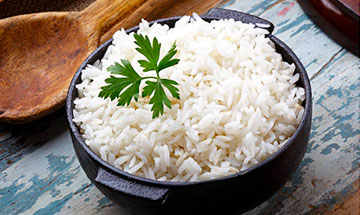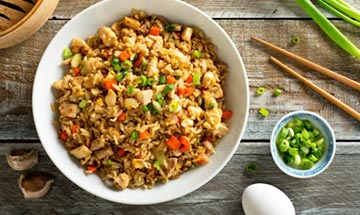Contents
Oryza Sativa is one of the oldest grains that humans have been cultivating. Probably it was around 5,000 years ago when people have developed a taste for this grass and harvested its grains. Around half of the world’s population have it as their staple food.
There are many variations but white colored ones are the most grown type. Specific countries and region produce different types that grow abundantly with given climates. Recently, brown variants are also taking off in the west because of their benefits to health.
Cooking white rice is a lot easier than cooking brown variants as they need to be cooked longer to be soft and chewy at the same time. Rice has also by-products including bran oil, flour, milk, and syrup.
Some people depend on this grain every meal for their carb intake, and they have never owned an expensive rice cooker to cook it perfectly. I know that electric cookers are popular because they make cooking convenient, and they have added features to cook many things porridge, soup, noodle, and risotto. But I am also aware of the fact that you can avoid buying a piece of expensive machinery to have successful outcomes. You are likely to have other kitchen tools and equipment that you can cook it with.
EQUIPMENT THAT YOU NEED FOR COOKING PERFECT RICE

Fine Mesh Strainer
Grains should be washed with clean water to remove the excess starch. Starchy grains will result in very sticky meals when nothing is done to reduce its starch content.
Measuring Spoons and Cup
Getting the right ratio between water and grains will make perfect rice. Some variants need equal parts of water, but some variants multiply in volume with more water without getting a soggy consistency. Some packages have specific instructions about the water needed.
Saucepan with Lid
Use a saucepan that has just enough space for the portion you’re making. Don’t use a large saucepan if you’re only cooking a serving or two. Wider surface might end up with burnt or toasted results.
Fork
Get that soft fluffy texture by using a fork to fluff the rice while it’s warm and before it is served. Grains will become too sticky and too dense if you don’t do something to introduce air among the grains. Stir it with a fork but not forcefully as it might break down its shape.
Ingredients: Yields 3 cups
- 1 tablespoon oil or unsalted butter (optional)
- 1 cup rice
- ½ teaspoon salt
3 WAYS HOW TO COOK RICE WITHOUT A RICE COOKER
Making rice without a rice cooker is possible. They didn’t have electric cookers to make their meals a long time ago. Here are ways to cook different types of this grain.
HOW TO COOK STICKY RICE WITHOUT A RICE COOKER

Steps:
- Put grains in strainer with fine mesh and wash it with cool running water until water runs clear. Rinsing remove the starch outside the grains. Each grain has already a lot of starch inside.
- Boil 1 and a half cup of water in a small saucepan with a lid.
- Give it a stir and add in washed grains, salt, and the oil if you’re using it.
- Reduce the heat setting to low. Put the lid on and cook for 18-20 minutes until water is fully absorbed.
- Turn off the heat and let it rest for about 10 minutes. Use a fork to fluff and serve.
HOW TO COOK BROWN RICE WITHOUT A RICE COOKER
Steps:
- Put grains in strainer with fine mesh and wash it with cool running water until water runs clear. Rinsing removes the starch outside the grains. Each grain has already a lot of starch inside.
- Over high, heat boil 8 cups of water in a medium-sized saucepan.
- Add in the brown grains without putting the lid on for 33-35 minutes until tender and chewy.
- Use a strainer to remove excess water. Put the brown rice back to the saucepan and steam for 10 minutes with the lid on.
- Season with salt and oil. Use a fork to fluff and serve.
HOW TO COOK JASMINE RICE WITHOUT A RICE COOKER
Steps:
- Put grains in strainer with fine mesh and wash it with cool running water until water runs clear. Rinsing removes the starch outside the grains. Each grain has already a lot of starch inside.
- Boil water in an electric kettle or a small pot: 2 parts of water for 1 part of basmati variant, 1 ½ cups of water for every cup of jasmine variant.
- In a saucepan, heat oil or butter until shimmering. Add grains and salt. Give it a stir until water evaporates and oil coats it evenly. Toast it slightly for 2 minutes until it smells toasted and you notice films of starch developing on the pan’s bottom.
- Add boiling water, set the heat to a low setting, and cook covered for around 18 minutes.
- Turn off heat and let it steam off for about 10 minutes. Use a fork to fluff and serve.

FREQUENTLY ASKED QUESTIONS
WHAT ARE THE BENEFITS OF RICE?
This grain is a good source of carb and fiber. All kinds of this grain have different amounts of resistant starch which are food to beneficial bacteria found in the gut. So this may improve one’s colon health and cut one’s risk of colon cancer.
Depending on the type used and cooking method, the nutrient value may be lower or higher. Darker colored ones are found to have higher traces of, selenium, thiamin, manganese, niacin, copper, and magnesium. Perhaps, the greatest benefit is it easily makes one feel full after a meal.
WHAT’S THE DIFFERENCE BETWEEN WHITE AND BROWN RICE?

Grains become whiter as they are refined and polished. The bran and the germ are also stripped off to increase its quality, extend its shelf life, and improve taste. The consequence is lower nutritional value compared to unpolished ones.
Brown variant is still intact containing both bran and germ. It’s under whole grains and is a better source of fiber. It also has more minerals, vitamins, as well as antioxidants. But we cannot say it’s perfect because it has antinutrients like phytic acid. There are also concerns of high heavy metal content depending on where they were grown.
Still darker variants are the winner for having higher nutritional quality. White variants don’t sit well with diabetic people, but brown variants, on the other hand, is a low-glycemic food that can be beneficial to lower blood sugar level. They are more expensive but definitely better choices.
WHAT ARE THE UNWANTED EFFECTS OF EATING RICE?

Everyday consumption might not be a good idea. It has been linked to higher risks of developing type 2 diabetes. Sticky variants get a special mention for having high glycemic content. It’s the variant that’s commonly used in Asia where there are plenty of people getting diagnosed with type 2 diabetes.
In contrast, many research have noted that whole grains such as brown rice reduce risk of developing diabetes. Researchers believe that this might be because of fiber contents. Anything taken too much has negative side effects. We should consume in moderation to prevent diseases and unwanted side effects.
HOW TO COOK PERFECT RICE WITHOUT A RICE COOKER?
Cooking grains without a rice cooker is not difficult. Cooking rice on stove can also give you that perfect fluffy consistency though it has more steps and needs more attention. We have three different ways to cook rice without a rice cooker above. But if you want to cook faster and easier check out mykitchenadvisor.com to find the best rice cookers on the market today. You can just rinse the grains, leave it to do other things such are preparing a side dish and get back to it after it’s done.







